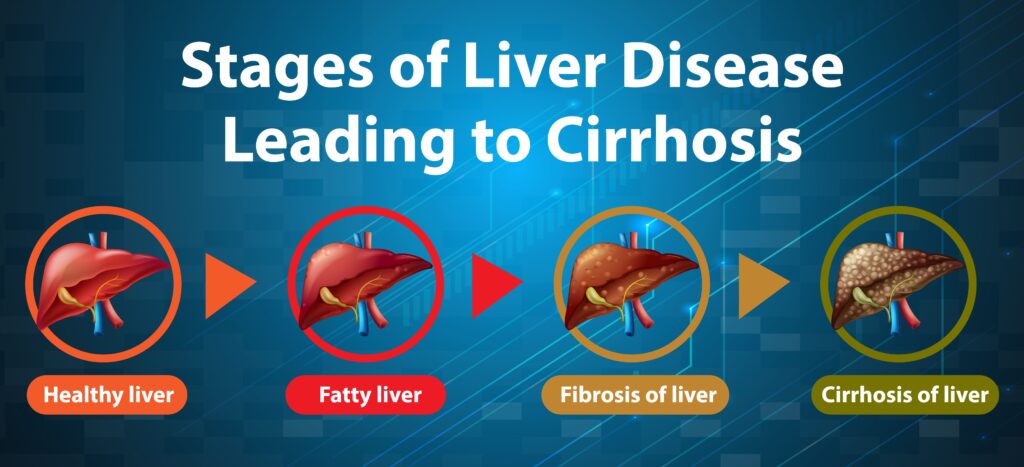As liver cirrhosis progresses, normal liver tissue is replaced with fibrous scar tissue, which gradually reduces liver function.
This extensive scarring makes it difficult for the liver to function correctly, leading to a decline in its vital roles, such as detoxifying the blood, producing essential proteins, and aiding digestion.
If left unmanaged, cirrhosis can lead to severe complications, including liver failure, and significantly impact a person’s quality of life.
At King’s Liver Transplant Centre of Excellence, we deliver expert, patient-focused care for liver cirrhosis in Dubai. Our specialists collaborate to provide accurate diagnoses, advanced treatments, and personalised management for the best possible outcomes.
Understanding liver cirrhosis
Cirrhosis develops gradually over months or years as a result of chronic liver injury. Each time the liver is damaged, it attempts to repair itself, but in the process, scar tissue forms. If the damage continues, this scar tissue accumulates, replacing healthy liver cells and impairing blood flow through the liver.
The liver becomes scarred and reduced in size, losing its ability to function efficiently. Common causes of liver cirrhosis include:
- Chronic viral hepatitis
- Non-alcoholic steatohepatitis (NASH)
- Alcoholic liver disease
- Autoimmune liver diseases
- Genetic conditions
- Bile duct diseases
- Certain medications

Stages and symptoms of liver cirrhosis
Liver cirrhosis often progresses through stages, categorised as compensated and decompensated:
Compensated cirrhosis: In the early stages, the liver can perform many functions despite scarring. Symptoms may be mild or non-existent, making early diagnosis challenging.
Decompensated cirrhosis: Progressive liver scarring compromises its function and can trigger major health complications. This is a critical stage requiring urgent medical attention.
Liver cirrhosis symptoms can vary and may not appear until the disease progresses. They can include:
- Fatigue and weakness
- Nausea and loss of appetite
- Unexplained weight loss
- Easy bruising or bleeding
- Itchy skin
- Jaundice (yellowing of the skin and eyes)
- Edema (swelling in the legs, ankles, or feet)
- Ascites (fluid accumulation in the abdomen)
- Confusion, disorientation, or slurred speech (hepatic encephalopathy)
- Dark urine and pale stools
- Spider angiomas (spider-like blood vessels on the skin)
- Enlarged spleen

Diagnosis of liver cirrhosis
Timely and accurate identification of liver cirrhosis is key to successful treatment. At King’s Liver Transplant Centre of Excellence, our Liver cirrhosis doctor Dubai utilises a comprehensive approach:
Medical history & physical exam: To assess symptoms and overall health.
Blood tests: Check liver/kidney function, clotting, albumin, and hepatitis markers.
Ultrasound: First-line imaging for liver size, texture, and ascites.
CT/MRI: Detailed imaging to detect liver complications.
FibroScan: Non-invasive test for liver stiffness (fibrosis/cirrhosis).
Magnetic resonance elastography (MRE): MRI-based liver stiffness measurement; more detailed than FibroScan.
Liver biopsy: Gold standard for diagnosing cirrhosis and its severity (used selectively).

Liver cirrhosis treatment in Dubai
The primary goals of liver cirrhosis treatment in Dubai at King’s Liver Transplant Centre of Excellence are to:
Address the underlying cause: This is the most crucial step. For example, antiviral medications for hepatitis B or C, alcohol abstinence for alcoholic liver disease, or weight management for NASH.
Prevent or manage complications: Treating the symptoms and complications of advanced cirrhosis is vital. This may include:
- Diuretics: To reduce fluid buildup (ascites, edema).
- Beta-blockers: To lower portal hypertension and prevent variceal bleeding.
- Lactulose and rifaximin: To manage hepatic encephalopathy (confusion).
- Antibiotics: To treat infections, especially spontaneous bacterial peritonitis.
Endoscopic procedures: Such as variceal banding, to prevent or control bleeding from enlarged veins in the esophagus (varices).
Transjugular intrahepatic portosystemic shunt (TIPS): A procedure designed to reroute blood flow within the liver, typically used to reduce portal hypertension and treat issues like variceal bleeding or persistent ascites.
Support liver function and nutrition: Nutritional guidance is crucial to combat malnutrition often associated with cirrhosis.
Monitor for liver cancer: Regular ultrasound and blood tests (AFP levels) screening is essential, as cirrhosis significantly increases the risk of hepatocellular carcinoma.
For patients with decompensated cirrhosis or end-stage liver disease, where the liver can no longer recover, a liver transplant becomes the life-saving treatment option.
Liver transplantation for end-stage liver cirrhosis
As a leading Liver Transplant Centre of Excellence, King’s Liver Transplant Centre of Excellence offers comprehensive evaluation and advanced transplant options for patients with end-stage liver cirrhosis.
Our expert team will meticulously assess your eligibility for transplant, guide you through the process of being listed for a donor’s liver, and provide meticulous care before, during, and after the surgery.
Liver transplant provides a life-saving option for those with irreversible liver damage, offering restored function and improved long-term outcomes.
Why choose King's Liver Transplant Centre of Excellence for liver cirrhosis treatment in Dubai?
At King’s Liver Transplant Centre of Excellence, we provide expert care for complex conditions like liver cirrhosis. Our internationally renowned hepatologists and liver specialists deliver advanced diagnostics, the latest treatments, and access to a leading liver transplant programme.
With a collaborative, multidisciplinary approach and compassionate, patient-centred care, we ensure every treatment plan is tailored to your unique needs.
If you or a loved one is facing liver cirrhosis or related symptoms, contact us today for a specialist consultation.
FAQs
While significant scarring (cirrhosis) itself is generally considered irreversible, treatment of the underlying cause (e.g., curing Hepatitis C, stopping alcohol consumption) can halt its progression and, in some cases, even lead to partial regression of fibrosis, improving liver function and preventing complications. Early diagnosis and intervention are key.
Common causes of liver cirrhosis in Dubai include chronic viral hepatitis (especially Hepatitis B and C), alcoholic liver disease, and increasingly, (NAFLD) and its more severe form, NASH, often linked to rising rates of obesity and diabetes.
Avoiding alcohol entirely is paramount for all cirrhosis patients. Maintaining a healthy weight, following a balanced, low-sodium diet (especially if you have fluid retention), managing diabetes, and getting
vaccinated against hepatitis A and B are all crucial lifestyle modifications that your Liver cirrhosis doctor Dubai will emphasise.
Regular monitoring is essential for cirrhosis patients. This typically involves frequent blood tests to assess liver function, imaging studies (like ultrasound or FibroScan) to track liver stiffness and check for complications, and screening for liver cancer (Hepatocellular Carcinoma) at regular intervals, often every 6 months.
Beyond addressing the underlying cause and managing complications, the field of liver cirrhosis treatment in Dubai is seeing advancements.
Research is ongoing in antifibrotic therapies that aim to reduce scar tissue directly. Regenerative approaches, including stem cell therapy and novel drug delivery systems, are playing a key role in supporting liver repair and boosting transplant results.
Minimally invasive techniques and advanced immunosuppressants are also improving liver transplant outcomes.


